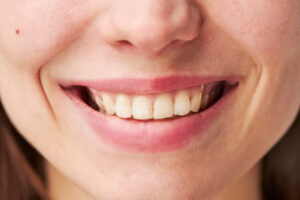A smile is one of your biggest assets. It can not only dazzle others but also boost your own self-confidence. One of the last things you want to show, then, are brown spots taking up space between your teeth.
Your teeth getting brown spots be the result of several issues, some simple and others a little more complicated. It’s essential to discover the source of such dental discoloration and determine how to deal with it sooner rather than later.
What Can Cause Teeth to Turn Brown?
Caring for your teeth extends to your overall health, and brown spots between them can alert you to certain issues. The good news is you can address and deal with these brown areas easily and keep that healthy smile you love.
Here are the more common reasons for your teeth turning brown in between.
- Tartar Buildup
Tartar buildup is most common between teeth and along your gum line. The tartar itself is porous and is highly susceptible to discoloration and staining. Foods, beverages, and other factors can turn it a noticeable brown color as a result.
The buildup of tartar on and between teeth is often the result of a lack of brushing and flossing on a regular basis. It can also serve as an alert you are developing gum disease.
While you may practice good dental hygiene, sometimes the tartar buildup occurs anyway. Schedule a cleaning as soon as possible. While this may take care of it, a deep cleaning is sometimes needed to help remove the most stubborn tartar buildup.
- Tooth Decay
Tooth decay damage can show up between teeth. The browning may indicate potential decay on each of the two teeth involved or just one of them.
The decay is often the result of consuming excessive amounts of starchy and sugary foods or drinks. Plaque will accumulate and stick to the surface of teeth, damaging them over time. If not treated, this plaque may destroy a tooth’s enamel and turn it brown.
- Dental Stains
A top reason you see your teeth turning brown is due to staining from the food and beverages you enjoy consuming.
Staining occurs on the outer surface (enamel) of your tooth. Various foods and beverages today lead to the staining, including red wine, coffee, tea, soft drinks, and dark sauces. Fruits such as blueberries and blackberries are also known to cause staining.
To help prevent staining from happening, try rinsing your mouth with water after consuming stain-causing food and beverages. You may also want to try sipping through a straw whenever possible to limit tooth exposure.
- Tobacco Use
If you smoke, vape, or indulge in dip or snuff, the brown spots between teeth may be attributable to your tobacco use.
While heavy staining commonly occurs behind your front teeth and in areas where you hold any smokeless tobacco substances, it’s possible the tobacco is also staining those areas between teeth.
Brushing regularly can help, along with a six-month checkup which includes polishing. For those experiencing deeper staining, you may need professional teeth whitening treatments.
- Certain Medications
Various medications, especially those in liquid form, can cause staining and discoloration between your teeth. For example, treating such health issues as gum disease may require a medicated rinse, which can lead to the brown spotting.
If you are just now noticing your teeth turning brown in between, look at what new medications you’ve been taking most recently. Substantial staining usually occurs within two weeks of use.
Check with your dentist to see if the browning is a surface stain. If so, a cleaning or whitening procedure may remove it.
- Fluorosis
Fluorosis occurs with the excessive ingestion of fluoride during the development of teeth. The more common way this can happen is through the natural mineral levels or well water you consume.
In other words, too much fluoride is not good for you and can lead to browning between the teeth. Children, in particular, are at risk for this fluorosis-caused discoloration.
To treat fluorosis, your dentist will need to assess the damage sustained to each tooth. Once determined, you will most likely need a restorative or cosmetic procedure to remove the discoloration or enamel damage.
- Age
Aging leads to the thinning and wearing down of tooth enamel. In turn, this thinning leads to a higher likelihood of absorbing stains from the various beverages and foods you consume.
While staining affects the overall tooth, it can be more noticeable in between your teeth if it is darker than on the tooth’s surface.
The browning may also come from underneath the tooth’s surface. The layer just under the enamel is called dentin and is naturally darker. When the enamel thins with aging, it can expose more of the dentin and appear brown.
Consider tooth whitening options to remove the brown areas, whether over-the-counter products or professional services.
Other less prevalent factors may also lead to teeth turning brown. These can be health or genetic conditions or even the amount of vitamins and minerals you consume.
Tips to Prevent Brown Spots
Whichever cause is responsible for your teeth turning brown, the following tips can help you avoid them in the future.
- Brush twice a day, and after consuming staining foods and beverages
- Floss between teeth at least once a day
- Rinse with water after consuming sugary or starchy foods or beverages
- Cut back on tobacco use
- Schedule regular dental cleanings
Seek Help from the Dental Health Professionals at Stiles Dental Care
If you notice brown spots on your teeth, and they’re not disappearing when you brush or floss, seek the help of Stiles Dental Care. Dr. Stiles and his team will examine your oral health and ask the right questions to determine potential causes.
While the browning between teeth is a cosmetic issue in many instances, other times it can indicate something more serious, such as tooth decay. Don’t delay in seeking help. Contact our office today to schedule an appointment.
